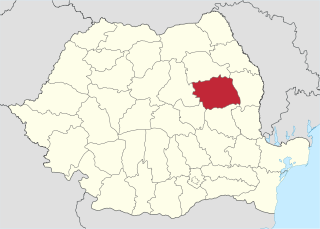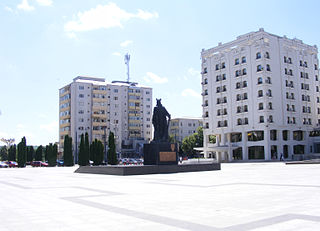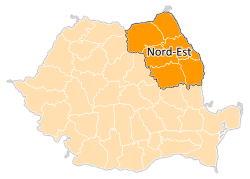
Botoșani County is a county (județ) of Romania, in Western Moldavia, with the capital town at Botoșani.

Vaslui County is a county (județ) of Romania, in the historical region Western Moldavia, with the seat at Vaslui.

Iași County is a county (județ) of Romania, in Western Moldavia, with the administrative seat at Iași. It is the most populous county in Romania, after the Municipality of Bucharest.

Bacău County is a county (județ) of Romania, in Western Moldavia, with its capital city at Bacău. It has one commune, Ghimeș-Făget, in Transylvania.

Vaslui, a city in eastern Romania, is the seat of Vaslui County, in the historical region of Western Moldavia. The city administers five villages: Bahnari, Brodoc, Moara Grecilor, Rediu, and Viișoara.

Piatra Neamț is the capital city of Neamț County, in the historical region of Western Moldavia, in northeastern Romania. Because of its very privileged location in the Eastern Carpathian mountains, it is considered one of the most picturesque cities in Romania. The Nord-Est Regional Development Agency is located in Piatra Neamț.

The development regions of Romania refer to the eight regional divisions created in Romania in 1998 in order to better co-ordinate regional development as Romania progressed towards accession to the European Union (EU). The development regions correspond to NUTS 2-level divisions in EU member states. Despite becoming increasingly significant in regional development projects, Romania's development regions do not actually have an administrative status and do not have a legislative or executive council or government. Rather, they serve a function for allocating EU PHARE funds for regional development, as well as for collection of regional statistics. They also co-ordinate a range of regional development projects and became members of the Committee of the Regions when Romania joined the EU on January 1, 2007.

Nord-Vest is a development region in Romania, created in 1998. As other development regions, it does not have any administrative powers, its main function being to co-ordinate regional development projects and manage funds from the European Union.

Sud-Est is a development region in Romania. As with other development regions, it does not have any administrative powers, its main function being to co-ordinate regional development projects and manage funds from the European Union.

Vest is a development region in Romania created in 1998. As with the other development regions, it does not have any administrative powers. Its primary functions are coordinating regional development projects and managing funds from the European Union.

Centru (Centre) is a development region in Romania. As other development regions, it does not have any administrative powers, its main function being to co-ordinate regional development projects and manage funds from the European Union.

Ținutul Prut was one of the ten Romanian ținuturi ("lands"), founded in 1938 after King Carol II initiated an institutional reform by modifying the 1923 Constitution and the law of territorial administration. It comprised parts of central Moldavia, and was named after the Prut River; its capital was the city of Iași. Ținutul Prut ceased to exist following the territorial losses of Romania to the Soviet Union and the king's abdication in 1940.

Slobozia is a city in Ialomiţa County, Romania.

Sud - Muntenia is a development region in Romania. As other development regions, it does not have any administrative powers, its main function being to co-ordinate regional development projects and manage funds from the European Union. It is located entirely in the historic region of Muntenia, with its Development Agency HQ in Călărași.

Sud-Vest Oltenia is a development region in Romania. As the other development regions, it does not have any administrative powers, its main function being to co-ordinate regional development projects and manage funds from the European Union.
In the NUTS codes of Romania (RO), the three levels are:

Moldavia, also called Romanian Moldavia, is the core historic and geographical part of the former Principality of Moldavia situated in eastern and north-eastern Romania. Until its union with Wallachia in 1859, the Principality of Moldavia also included, at various times in its history, the regions of Bessarabia, all of Bukovina, and Hertsa; the larger part of the former is nowadays the independent state of Moldova, while the rest of it, the northern part of Bukovina, and Hertsa form territories of Ukraine.

Roman County is one of the historic counties of Moldavia, Romania. The county seat was Roman.


















